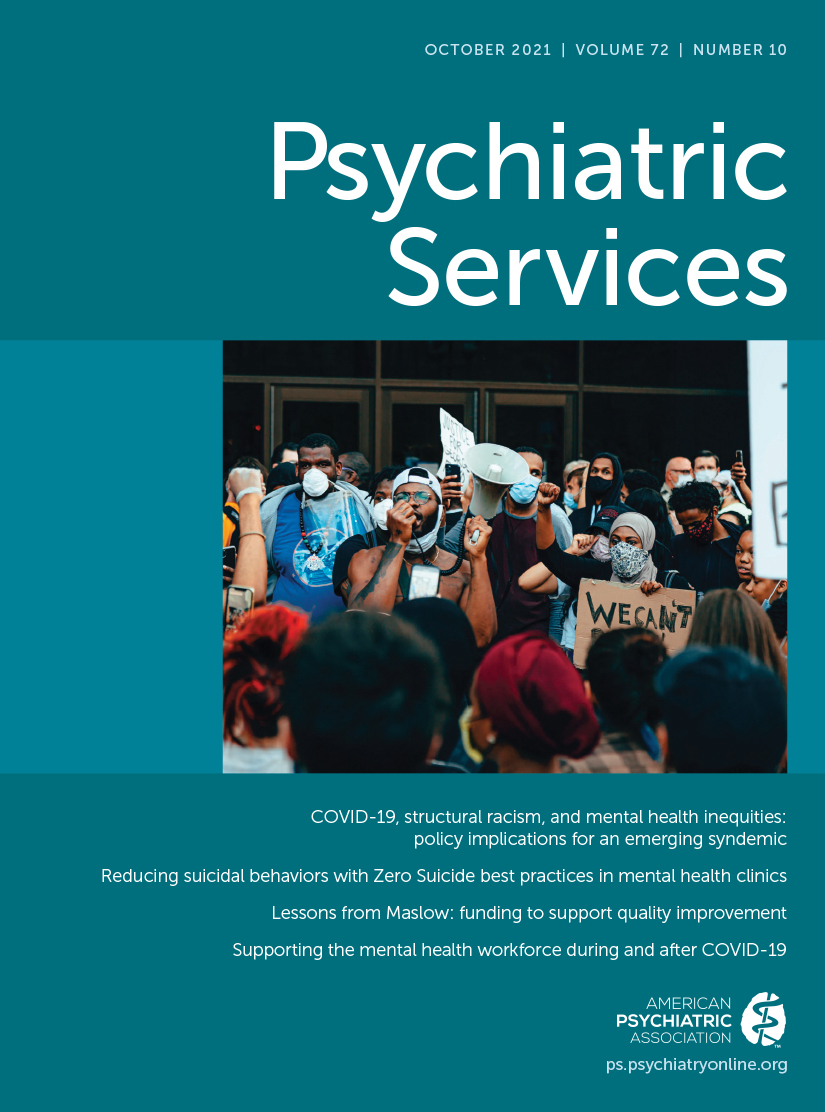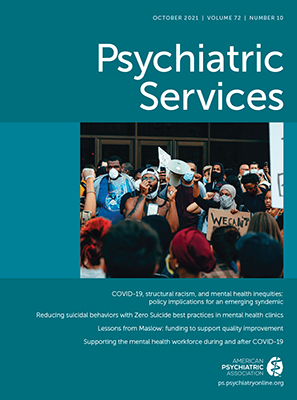Pediatric psychiatric disorders are common; 16.5% of U.S. youths have at least one psychiatric disorder (
1), and rates are increasing (
2). Unfortunately, there is a dearth and unequal distribution of child psychiatrists to address the growing need for mental health care (
3). To address this need, the American Academy of Pediatrics has recommended that pediatric primary care clinicians (PPCCs) enhance their skills and comfort with managing common pediatric psychiatric disorders (
4) through collaborations with mental health specialists.
Child psychiatry access programs (CPAPs) offer an integrated care approach to increase access to treatment for youths with psychiatric disorders by increasing capacity to manage these conditions in pediatric primary care settings (
5). Nationwide, approximately 30 CPAPs provide telephone consultation with a child psychiatrist regarding management of pediatric psychiatric disorders. Many CPAP’s also provide continuing education, resource and/or referral networking, and one-time psychiatric evaluation. For example, Washington State’s CPAP (called the Partnership Access Line) includes one centralized team of child psychiatrists and other behavioral health clinicians who provide training through regional conferences, telephone consultation, and resource/referral networking for PPCCs in Washington and two neighboring states (
https://nncpap.org/).
Previous research has described characteristics of primary care practices that use CPAP services (
6), provider and practice CPAP service usage (
7,
8), provider and patient satisfaction with CPAP services (
7,
8), and the impact of CPAPs on provider comfort, practice change (
5,
9), and patient outcomes (
10). Although these studies suggest that the CPAP model is a promising approach to help close the mental health services gap, few studies have investigated the characteristics of providers who use CPAPs. The purpose of this study was to describe the types of PPCCs who call CPAPs and to examine how provider characteristics relate to program usage. We hypothesized that the volume and type of calls to the CPAP would vary as a function of provider characteristics (e.g., type, specialty) and that PPCCs in rural regions with limited mental health services would use the CPAP differently than providers in urban areas with more services. Thus, this study was undertaken to increase understanding of the providers most likely to take advantage of CPAPs.
Methods
Maryland Behavioral Health Integration in Pediatric Primary Care (BHIPP), a CPAP located in two universities in Baltimore, provides free continuing education, clinical consultation, and resource and referral networking, Monday through Friday, 9 a.m.–5 p.m., to Maryland PPCCs. Similar to other CPAPs, BHIPP has a warmline staffed by master’s-level behavioral health specialists who collect deidentified patient information from PPCCs seeking services, answer general behavioral health questions, and assist PPCCs in connecting patients to relevant community-based services. When clinical consultation is requested, calls are triaged and sent to the child psychiatrist on duty. For this study, telephone requests to assist PPCCs in connecting patients to community-based services were designated as referral calls, whereas requests for consultation with a child psychiatrist were designated as consultation calls.
The sample included 676 PPCCs who contacted BHIPP at least once between October 2012 and June 2019 for consultation and/or referral. Institutional review board approval for the study was obtained from Johns Hopkins University, University of Maryland, and the Maryland Department of Health.
Demographic information, self-reported during BHIPP enrollment, included provider type (e.g., allopathic [M.D.] or osteopathic [D.O.] degree), specialty (e.g., pediatrics), years in practice, gender, race-ethnicity, and types of insurance accepted. If provider gender was missing on the enrollment form, data were drawn from the National Plan and Provider Enumeration System. Urbanicity was determined on the basis of the county where the provider practiced. Counties were dichotomized as rural or semirural, or urban or suburban, as specified by the rural-urban commuting area codes (
11).
Reasons for calling and call volume were drawn from the BHIPP database through June 2020 to allow sufficient time for PPCCs enrolling in June 2019 to have called multiple times. Reasons for calling were categorized as requests for general information, consultation, referral, or not appropriate and were documented at the time of the call. Calls deemed not appropriate included those seeking emergency services or direct patient care.
Descriptive statistics were used to describe call volume and frequency. PPCCs were categorized into two caller-frequency groups guided by prior research (
5): low-volume callers (LVCs), who called one to six times, and high-volume callers (HVCs), who called seven or more times. PPCCs were also categorized by the reason they called BHIPP: consultation only, referral only, consultation and referral, or other. Bivariate analyses were used to compare provider characteristics and call type by caller frequency. Multinomial logistic regression was used to examine characteristics of PPCCs that predicted call type. All analyses were conducted in SPSS, version 26.
Results
PPCCs made a total of 4,779 calls to BHIPP between October 2012 and June 2020. Annual call volume steadily increased over time, from 55 calls in fiscal year 2013 to 997 calls in fiscal year 2020. Frequency of clinician contact ranged from one to 176 times, with providers contacting BHIPP a mean±SD of 2.85±6.92 (median=1, maximum=77) times for consultation, 3.57±11.75 (median=1, maximum=171) times for referrals, 0.24±0.65 (median=0.00, maximum= 7.00) times for other reasons (e.g., general information), and 6.82±14.90 (median=2.00, maximum=176.00) times across all call types. Thirty-eight percent (N=256) of PPCCs called once, 15% (N=104) called twice, 9% (N=58) called three times, 7% (N=47) called four times, 5% (N=31) called five times, 3% (N=23) called six times, and 23% (N=157) called seven or more times.
Table 1 compares characteristics of providers calling BHIPP by caller frequency. Most providers (77%) were LVCs, whereas 23% were HVCs. There were significant differences by caller frequency. HVCs were more likely to have an M.D. or D.O. degree, whereas LVCs were more likely to have other credentials (e.g., nurse practitioners, physician assistants, nurses). HVCs were more likely to be pediatricians and were less likely to specialize in family practice or another specialty. HVCs were more likely to accept uninsured and publicly and privately insured patients than were LVCs. Provider race-ethnicity also varied. HVCs were more likely to be Asian or White compared with LVCs, who were more likely to be of “unknown” race-ethnicity. There were no differences in caller frequency by gender, years in practice (t=−0.22, df=373, p=0.82), or urbanicity of the caller’s practice. However, call type varied by caller frequency, with HVCs more likely than LVCs to call for both consultation and referral and less likely to call for consultation or referral alone or for another reason.
A multinomial logistic regression was conducted to examine predictors of call type, with calling for consultation and referrals as the reference group. Providers calling only for other reasons were excluded from the analysis to limit the focus to patient-specific CPAP contacts. Compared with those calling for consultation and referral, providers calling for consultation only were less likely to be pediatricians (odds ratio [OR]=0.37, 95% confidence interval [CI]=0.19–0.69, p=0.002) or HVCs (OR=0.10, 95% CI=0.05–0.15, p<0.001) and had a similar likelihood of practicing in rural or semirural areas (OR=1.01, 95% CI=0.52–1.98, p=0.98), being female (OR=0.73, 95% CI=0.40–1.32, p=0.30), and having an M.D. or D.O. degree (OR=1.16, 95% CI=0.69–1.93, p=0.57). Providers calling for referral only were less likely to be pediatricians (OR=0.27, 95% CI=0.14–0.51, p<0.001), HVCs (OR=0.11, 95% CI=0.06–0.18, p<0.001), or practice in a rural or semirural area (OR=0.47, 95% CI=0.21–1.01, p=0.05) and had a similar likelihood of being female (OR=1.31, 95% CI=0.69–2.48, p=0.42) and of having an M.D. or D.O. degree (OR=1.40, 95% CI=0.83–2.36, p=0.20), compared with those calling for consultation and referral.
Discussion and Conclusions
Most prior research on CPAPs has focused on practice-level characteristics of primary care practices using CPAP services, use of CPAP services, provider and patient satisfaction with CPAP services, or characteristics of patients for whom PPCCs sought CPAP consultation (
6–
10). This study examined characteristics of the PPCCs calling one CPAP and identified distinct types of clinical users. Our results are consistent with prior studies, which have shown that providers contacting CPAPs tend to be pediatricians, have an M.D. or D.O. degree, and accept uninsured as well as publicly and privately insured patients (
9)—findings that are in line with demographic information on PPCCs nationwide (
12).
Our study differed from the literature in terms of the reasons the providers called BHIPP. Prior research by the Massachusetts CPAP found that their most frequent callers sought consultation regarding medication management, whereas their least frequent callers sought referrals (
5). BHIPP’s HVCs were more likely to have called for consultation and referrals and less likely to have called only for consultation, referral, or another reason. This difference, however, may have been secondary to the unique design of the Massachusetts CPAP, which has regional treatment teams that form relationships with primary care practices in their region and provide phone consultation, referrals, and in-person evaluation (
6). In contrast, the Maryland CPAP’s design is similar to that of the Washington State CPAP and other CPAPs, in that it was designed to fit a lower population density, with less even dispersion of child psychiatrists, and consists of a single, centralized team of psychiatrists and behavioral health specialists who provide consultation and referrals via telephone to providers throughout the state. Of note, the volume of calls to BHIPP was comparable with that of Washington State’s CPAP (
7). Given the dearth of research on the PPCCs who contact CPAPs, the mechanism behind differences between HVCs and LVCs can only be speculated on and may include improvements in provider comfort in addressing pediatric psychiatric disorders after one to three calls.
As expected, those contacting BHIPP for consultation were more likely to be from rural areas, where gaps in access to pediatric mental health services are greater. This finding suggests that clinicians in rural areas are more willing than those in urban or suburban areas to expand their scope of practice to include medication management of psychiatric illness if consultation is available. Thus, collaboration between CPAPs and PPCCs in rural areas is essential to increase access to mental health services and underscores the continued need for CPAPs to provide clinical education and training to increase provider confidence in managing the care of patients with mental health conditions. As a result, BHIPP has launched TeleECHO Clinics, a web-based learning collaborative that uses the Project ECHO framework (
https://echo.unm.edu/). Through synchronous virtual learning sessions, these clinics, staffed by BHIPP psychiatrists, provide clinicians with didactic education and case-based learning to improve their recognition and treatment of pediatric psychiatric disorders.
This study was limited by missing demographic data. Because not all callers to BHIPP completed the enrollment survey, some information (e.g., race-ethnicity) was missing for some callers. However, the demographic data collected were in line with demographic data of PPCCs nationwide. In addition, the amount of missing data was comparable to survey nonresponse rates in other CPAP studies (
7). Finally, the recent increase in nonphysician providers of pediatric care may have contributed to an overrepresentation of physician providers among HVCs, because these providers may have had a longer time to access BHIPP services.
In conclusion, addressing pediatric psychiatric disorders is a complex, nuanced problem. However, CPAPs are a small step forward to increase access to pediatric mental health services. As the country moves to population-based reimbursement (versus fee for service), integration of primary and specialty care will become more important. Increasingly, PPCCs will facilitate services once provided by specialists. An understanding of the characteristics of PPCCs most likely to take on specialty care will inform efforts to deepen PPCC knowledge and skills in providing specialty services. Future directions include studying the types of patients and clinical issues for which PPCCs seek consultation and referrals, examining the impact on pediatric mental health care of expanding CPAP services to include training for these providers in managing psychiatric disorders via mechanisms such as Project ECHO, and increasing access to child psychiatrists via telepsychiatry.

